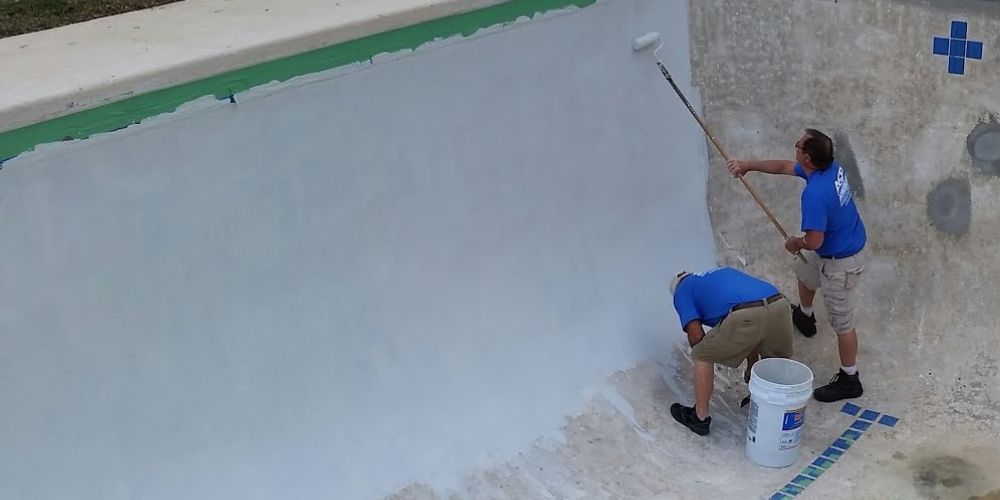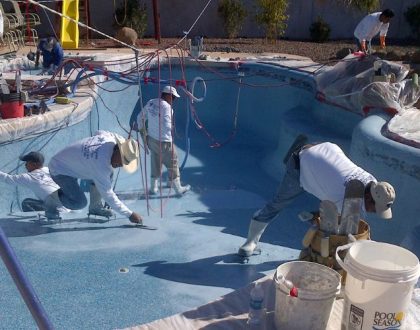Tips for Resurfacing Your Swimming Pool

A pool in your backyard is the perfect way to escape the heat of the summer, and to relax with family and friends. But if your pool’s finish has become cracked or peeled, it can turn a nice pool day into an uncomfortable hassle. If your pool is showing these signs, it’s time to get it resurfaced. For first time pool owners, resurfacing may seem like a huge project that will take lots of time and money. However, it can be quite simple and easy. Follow these tips if you’re looking into swimming pool resurfacing.
Don’t Limit Resurfacing to Off Seasons
If you’re waiting for the prime pool months to end before you get your pool resurfaced, don’t! If you notice your pool is cracked or peeling, it’s best to get it resurfaced immediately, as putting it off could lead to further damage. Taking a few days off from the pool to have it fixed is a much better trade off than allowing it to become more damaged.
Resurfacing typically takes around a week to complete, so you won’t be missing too much of the swimming season.
Use a Durable Finish
While the most popular and budget friendly option for resurfacing is typically plaster, it is also the least durable of your choices. If you are looking into getting your pool resurfaced, we would recommend going for a finish that will last longer and stand up to any conditions. Making the larger investment one time is better than to keep getting your pool repaired over and over.
Some more durable finishing options include pebble-based cement, quartz, tile, aggregate, and many more. We would look into the pros and cons of each option before making a decision, as every individual pool will need different solutions.
Ditch the Pool Patches
For some, pool patches may be an attractive option since they are much easier to apply and will take less time and money. We would advise against using these, as they will often not be as durable over time as a complete refinish. Patches are a much more temporary solution as they do not solve the problem but simply cover it.
Also, pool patches may not always adhere perfectly to the old material in your pool. If the patch comes off, you’re still going to have to get the pool repaired, unless you want to continue buying patches every time they wear down.
Types of Finishes
Now that we’ve gone over some important tips to keep in mind before resurfacing, let’s get into the different types of finishes available to you.
Plaster Pool Finish

Pool plastering is one of the most used finishes. It is hard and smooth and is normally white in color. Plaster gives your pool water a nice light blue tint, which makes it an attractive option for many pool owners. Plaster is also able to be dyed, which could be important for those looking for customization options.
Another upside to plaster is the cost. Since plaster is usually comprised of just sand and cement mixed together, it is a relatively inexpensive option compared to other finishes.
However, plaster does come with its cons. Plaster normally requires more maintenance than other, more expensive finishes. It is much easier to stain due to its porous nature. It also accommodates algae, which means plaster requires fairly frequent maintenance and washing.
The cheaper price also means less durability. The average pool plaster will only last around five to ten years before a complete resurfacing is required.
Aggregate Pool Finish

Aggregate pool finishes have grown in popularity in recent years due to their nice aesthetics and solid durability. These finishes contain river pebbles, stones, ceramics, and glass, which combine with plaster to make a much more durable and aesthetically pleasing product.
Aggregate finishes also allow pool owners to leave them polished or exposed, which is good if you’d like to have a textured finish on the surface of your pool. Aggregate finishes are also much more resistant to pool chemicals and will last much longer than plaster.
Aggregate finishes have been known to last anywhere between 15 to 20 years. This longer life span also comes with a larger price tag, as aggregate finishes are more expensive than plaster. However, if you have the budget, and would like to resurface your pool less frequently, an aggregate finish may be right for you.
You should now know a lot more about what goes into resurfacing, when you should do it, and a couple of the options that are available to you. Keep in mind that there may be a lot more to resurfacing your pool, especially if it requires other pool renovation. However, a simple pool resurfacing job can transform your old, rough pool into the perfect venue to combat those higher temperature days with your loved ones!
Recommended Posts

Great Ways to Update Your Aging Pool and Deck
December 20, 2022

When is the Right Time to Remodel Your Pool?
October 31, 2022
